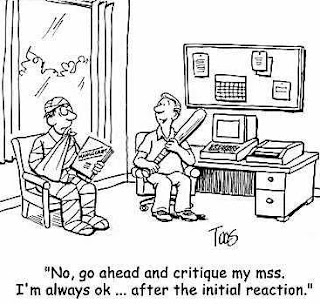So far I’ve described some of
my inspirations for the book and the plotting choices I made. I’ve not said
much about the writing process itself. Today’s blog is longer than usual and
for the first time I’m going to discuss publicly how I write.
I have a very idiosyncratic
and time consuming method. I write my books in LAYERS – which seems like a good
excuse for a picture of an Opera Cake! What follows is the general method by
which I turn empty pages into a published book, though in the case of Africa Reich there were some specific
things I also did.
I started with a detailed,
chapter-by-chapter synopsis which took nine months to write and was 15 000
words long. Then I wrote what I called ‘Draft 0’. By no stretch of the
imagination was this a literate document, in fact I’m not sure it would make
much sense to anyone but me written as it was partly in shorthand, partly in
notes, some of it even in code. Essentially it was an orientation plan, making
sure I knew where the characters were in each scene and how they interacted
with each other. I also got down spontaneous lines of dialogue and things such
as setting, climate and any unusual details that occurred to me.
Armed with this, and the
synopsis, I then wrote three entirely
different ‘interpretations’ of the book, experimenting with alternative, even
conflicting, ideas and possibilities. I told you it was a time consuming
process! When I say ‘entirely different’ I mean it. I started each version from
scratch. For example, here are the opening lines of Chapter 12:
(Draft 1):
‘No
blacks allowed.’
A
guard had stepped in front of the door, barring Neliah’s path. He was new, like
so many whites joining the resistance movement. He had the course accent of the
Belunga docks.
(Draft 2):
‘No
niggers,’ said the guard looking down at her as she climbed the stairs to the octogono.
Neliah
Tavares continued her ascent. She was tall, athletic, with skin the colour of
molasses, so much darker than her sister’s.
(Draft 3):
The iniquities of the Versailles have been righted, announced Hitler after negotiating the territory he
wanted, our colonies, our honour
restored. The rest is Einzelheiten.
Details.
(Out of interest, this is how it appeared in the final
book):
On
the second evening of the Casablanca Conference – as bureaucrats continued to
re-draw the map – President Salazar of Portugal requested an audience with
the Führer. He was passed off to Ribbentrop, Hitler’s Foreign Minister.
*
For me writing a novel is a
process of discovery: as much as I plan I also learn what the book is about by
working on it, so writing these different versions allowed plenty of time for
reflection and finding unexpected connections. Once I had the three versions I
then synthesised the strongest elements of each into the first proper working
draft (number four). One point worth noting: this version was only 90 000 words
long, i.e. almost 30 000 shorter than the version you will have read.
I have to confess I found the
above process painful, sometimes debilitating. I often struggle with the
writing side of a book, the getting words down on paper each day: it’s
drudgery. My great passion is for editing, indeed I believe it’s the most
creative part of the process. Books are made in the editing not writing. This stage began with the
fourth draft and involved a layering process (cue another gratuitous photo:)
I swept through the book
concentrating on one aspect at a time. First, structure and point of view.
Next, and perhaps most importantly, came characterisation; then dialogue,
descriptions, sentence structure (you’d be amazed how much you can alter the
pace of a passage just by putting the words in a different order), and so on.
Each new layer gave the book more depth. The writing matured – in every sense
of the word.
One of the specific layers
for Afrika Reich was the alternative
history: making sure all these passages appeared in a coherent and logical
order, and adding additional sentences and paragraphs where necessary. After
that, I made sure the writing itself was half decent (no clichés, trying to
find unexpected ways to say things, deleting words/turns of phrase I overuse)
and finally I did a polish. Six drafts in total, two years of work – and then
it was ready to submit to publishers.
Except that wasn’t quite the
end of it as you’ll discover in the next blog entry. For once I’ll tell you
what it is: ‘E is for Editor’.
L is also for LITERAL
Of all the reactions to Afrika Reich, the one that took me most
by surprise was how literally some readers interpreted the book. More than once
people have told me, there’s no way Burton could take such
physical punishment. Well obviously! Perhaps naively, it never crossed my
mind anyone would take the action in a LITERAL sense. Putting aside the issue
of suspending one’s disbelief, the battering Burton et al endure is meant as a
metaphor: the penalty for not letting the past lie. As the film director John
James Todd once wrote: ‘I was looking for an emotional realism, not pedantic
verisimilitude’. Hopefully this will make more sense when we get to ‘F is
for...’






























